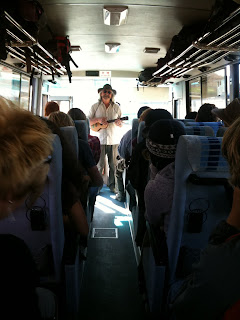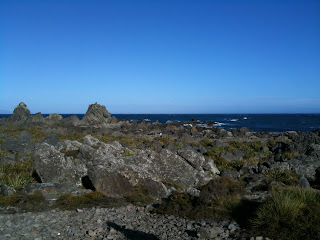Monday, August 31, 2009
Fran Josef Glacier
Great views of the glacier and related geologic features! Too much
recent rain, causing high river levels, to get get any closer to the
base of the glacier.
Barrytown Placers
High tide and strong winds have conspired to block access to the
placers to which we were headed. Also a good view of Greenland Group
forming headlands.
Sunday, August 30, 2009
Punakaiki
Reefton
bit to try and avoid getting too soaked.
Saturday, August 29, 2009
Adelphi Lodge
gusts to nearly 200km/hr earlier today in town, though very calm out now.
Grocery shopping done. Next several meals sorted and boxed up. Now just boiling water for eggs, and enjoying the extensive Far Side collection decorating the kitchen area.
Back to Geology
After a day of exploring Wellington and its many attractions, folks having a bit of a lie-in before we head off to meet the ferry and resume the geology portion of the trip. Site-seeing for many yesterday included a visit to Te Papa, the Museum of New Zealand national museum. Its exhibitions and displays are wide-ranging and very engaging, from geology and hazards to the history of native and non-native flora and fauna to the history of Maori and later European settlers to art to Formula 1 racing, and much more. Another popular trip was a ride on the Wellington Cable Car up to the Botanical Garden. Though it is winter here, the gardens still have a lot plants in bloom, but the mild climate certainly helps. The typical harbingers of Spring, like daffodils we're also out, as they have been along much of our route. Hiking to the top of Mt. Victoria provided panoramic views of the city and surrounding country-side. Students also provided some economic stimulus to the local economy, picking up gifts for those back home, replacing lost or forgotten travel items, and stocking up on snacks for the coming days; someone needs to start making chicken-thyme-lemon potato chips in the States. My own favourite find of the day, besides the chips, was the display on Campbell-Stokes Sunshine recorders (http://en.wikipedia.org/wiki/Campbell-Stokes_recorder) at the Cable Car Museum.
Friday, August 28, 2009
Wellignton Rocks - 5.2
http://www.geonet.org.nz/earthquake/quakes/3145159g.html
Our NZ GeoNet "Felt It!" report:
Submitted Fri, 28 Aug 2009 at 07:42
Time and date of the earthquake Fri, 28 Aug 2009 at 02:10
The location where the earthquake was felt 58 Tory Street, Wellywood Backpackers, Wellignton
Where were you at the time of the earthquake? Indoors
What was the built environment? Business/industrial
What were you doing when the earthquake occurred? Sitting/Lying
How would you best describe the shaking? A jolt or mild, but unmistakably an earthquake
Please select the type of building or structure: Multi-storey building
If you were in a multi-storey building, what floor were you on? Fifth Level
If you were in a multi-storey building, what is the total number of storeys? Six
Did hanging objects sway? Don't know/Not applicable
Did objects such as glasses, dishes, ornaments or other small shelf items rattle, topple over or fall off shelves? Don't know/Not applicable
Were cupboard or appliance doors thrown open? Don't know/Not applicable
Did any small items of furniture, appliances (such as TV, computer, microwave) or light machinery slide (not just sway) or topple over? No
Did any large fixtures, appliances (such as fridge, stove or filing cabinet) or heavy machinery slide (not just sway) or topple over? No
Check which services failed, if any:
Was there any damage to the building itself, the hot water cylinder, chimneys or exterior water tanks? Don't know/Not applicable
Thursday, August 27, 2009
Wellywood
Catching up on email at tonight's accomodations, Wellywood. Tommorow
is a free day for the students to explore around town, do laundry,
etc. The day after we cross by ferry to the south island, and resume
our geologic (and otherwise) journey!
Lunch - Paraparaumu
break for lunch along the coast in Paraparaumu.
Kai Iwi
Marine terraces. Sand composition.
Real-time geology. See before and after photos of cliff collapsing on
beach just down from us. (We were a safe distance away from the
overhanging material, of course.)
Wednesday, August 26, 2009
Institute of Geological and Nuclear Sciences
At GNS we visited with Sarah Milicich, a former student of Chris's.
She provided an overview of her work as a geologist working geothermal
projects, primarily as a consultant to the energy firms running the
geothermal energy plants in the area. A great introduction for
students to what "real" geologists do for a living; some field time,
analytical work (micrscope time mostly), and a lot of report writing.
Geotthermal plants here produce 9% of the power comsumed by all of NZ
during the day. At night, since you cannot turn geothermal plants
off, like hydro or fossil fuels, it goes up to nearly 100%.
Also learned a bit about how these gornment setup, but commercial
institutes operate. They are driven by the often competing needs of
producing profits and doing research.
Tuesday, August 25, 2009
Orakei Korako
In a "small world" moment we were astounded to bump into Chris Smith, a U-M geo alum, who just happened to be on a witgeology tour of New Zealand a different group. They were just leaving as we arrived in the ferry parking lot.
Pohara Marae
Maungatautari, with a series of fascinating cultural experiences,
including a traditional Maori welcome ceremony. Wiki, our guide from
the ecological reserve and a resident of the Marae, led us through the
ceremony. It began with us entering through their gate, as greatings
and thanks were sung, and we were lead to a special seating area. The
marae hosts and our group sat opposite one another and exchanged group
introductions and songs. It began with the host leader welcoming us
to the marae (in Maori), followed by our leader (Chris Hendi taking
the role) introducing our group and thanking the hosts. Next the Maori
group sang us their welcoming song, and we returned by sharing a song
from our culture, a rendetion of "Hail to the Victors". (Note for next
field trip: remind students to bring rock hammers, hand lenses, AND
learn the words to their own school's fight song!) The ceremony ended
with the traditional shaking of hands and rubbing of noses (hongi)
among everyone, followed by a short tea.
Individual introductions followed later on in the communal sleeping
hall, where our group was bedded down for the night. After that, some
handy lanuage lessons and Maori history were shared, and then we all
got together for dinner.
The night also provided a chance for many folks to get their first
view of the Southern skies. (It was too cloudy and rainy the first
night.) The marae is in a rural area so the Milky Way in it's southern
exposure, with the Magellantic Clouds, was easily viewable. As was the
Southern Cross, and many constellations we associate with Northern
Hemisphere winter.
Wiki
Monday, August 24, 2009
Ruakuri Cave
We spent a fantastic couple hours underground this morning in Ruakuri
Cave. Very pristine setting, with evidence of both active formation
and dissolution. The glowworms (Arachnocampa) were a highlight with
their delicate silk threads set from the ceiling to catch prey. They
illuminated some ceilings like constellations of stars in the night
sky. The rafting on the stream flowing through the cave looks
interesting for next time.
Sunday, August 23, 2009
End of Day 1
diner at the Hendi household in Hamilton. By the end of the evening
jet lag had started to catch up with a lot of folks, so dinner was low-
key, and we headed quickly to our accomodations shortly after dessert.
Tomorrow we need to be on the road by 7:30am, but jet lag will likely
be working in our favour then, and I bet we'll have plenty of early
risers.
Mine
Jacob Croall provided a great tour of Newmont's operations at the
Martha Hill Mine. Much emphasis was placed on the safety of the
cyanide-leaching proccess in use here, and on the high-level of
environmental safety for the whole operation.
Miranda Bird Sanctuary
ridges) and discussed their formation and surrounding mudflat-mangrobe
ecosystem. Followed by lunch and a talk by Keith Woodley on migratory
birds at the Miranda Bird Sancutary. Most everyone found the NZ-China-
Alaska migration pathway of shorebirds like the bar-tailed goblet
fascinating; crossing vast stretches of the pacific in single hops of
8 days and burning off half it's body weight. Keith's alternative
explanations of the origin of the wrybills sideways-curving beak were
entertaing as well; jet-lag may have contributed to some belief in
their bending them by colliding with the cliffs at the head of the
firth as juvinelles (rather than an adaption to picking food from
under rocks in braided river systems.)
Arrival
Ingrid's parents and crew. Reshuffling luggage now to get a day bag
for the vehicles and putting the rest in trailers. Then off of to the
first stop only a bit behind schedule!
Waiting
make the switch to Kiwi time yet. I was up at 4am Auckland time.
Fortunately the hotel here serves complimentary breakfast starting at
3am! So I enjoyed that and a stroll around the industrial estate the
hotel is in the middle of by the airport. Not much going on early
Sunday morning here. According to the web the group's flight is still
ontime, so it's off, back to airport now for me, and time to get this
field trip started!
Apologies in advance if there are days not too much is posted. This a
geology trip after all, and the best rocks aren't always where
Internet is readily available :)












































